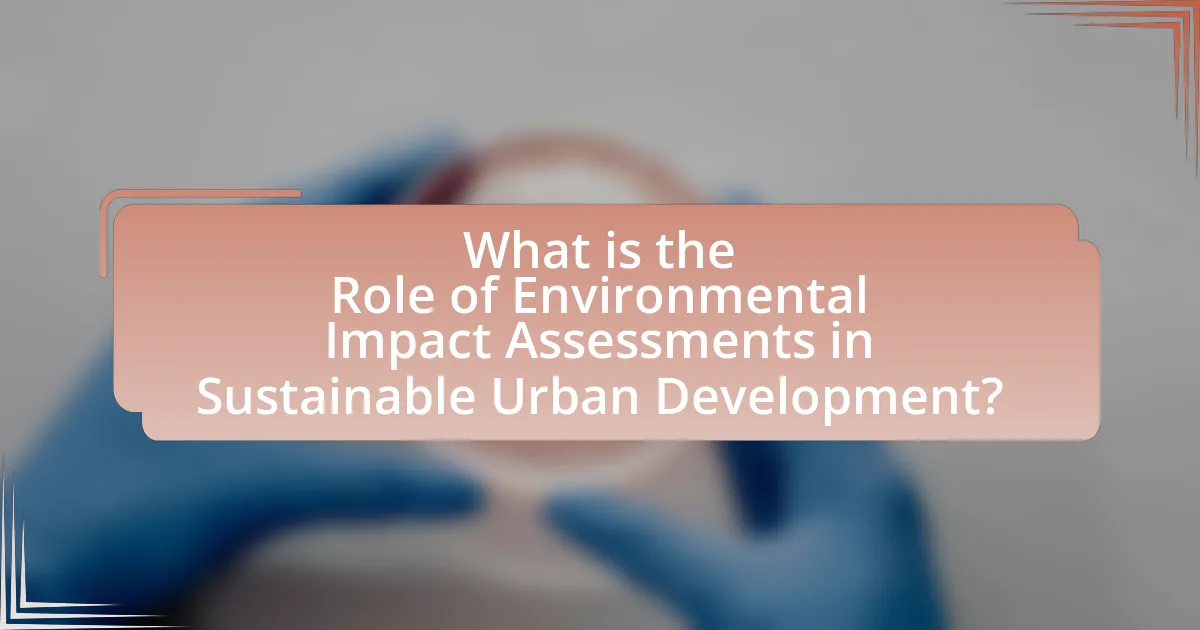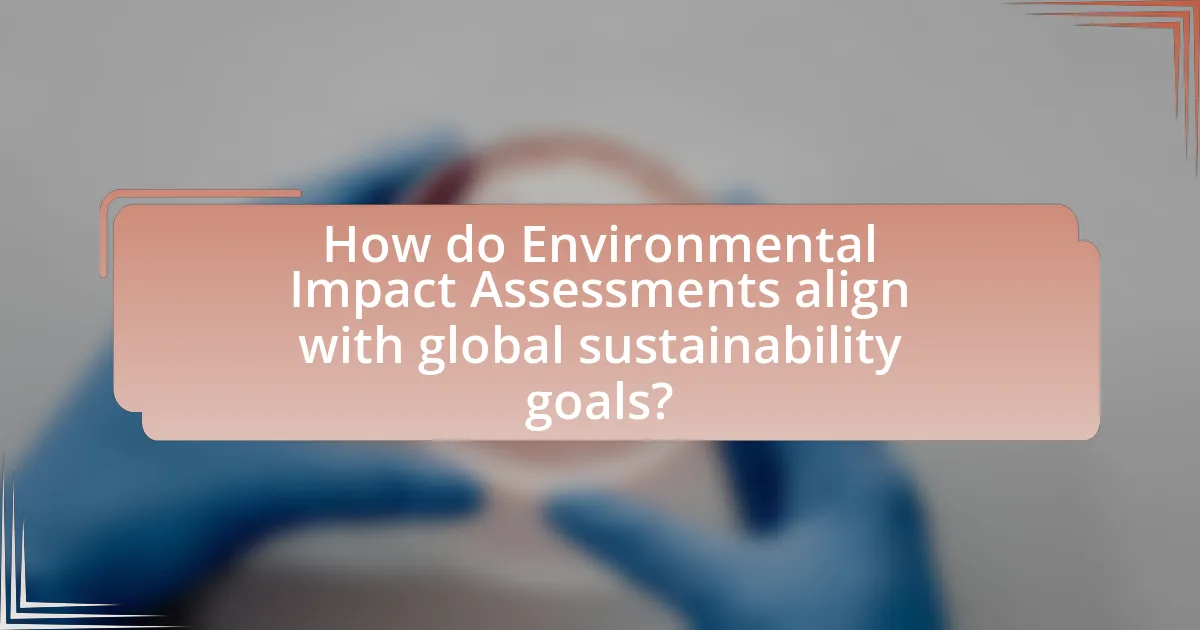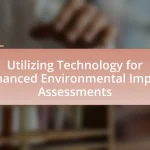Environmental Impact Assessments (EIAs) are essential tools in sustainable urban development, evaluating the potential environmental effects of proposed projects prior to their approval. This article outlines the critical role of EIAs in urban planning, highlighting their components, such as impact analysis and public participation, which contribute to informed decision-making and community engagement. It discusses the benefits of EIAs, including enhanced public health, economic advantages, and alignment with global sustainability goals, while also addressing challenges faced in the assessment process. Furthermore, the article explores future trends and innovations in EIAs, emphasizing the importance of integrating technology and stakeholder involvement to improve outcomes in urban development.

What is the Role of Environmental Impact Assessments in Sustainable Urban Development?
Environmental Impact Assessments (EIAs) play a crucial role in sustainable urban development by evaluating the potential environmental effects of proposed projects before they are approved. EIAs ensure that decision-makers consider environmental factors, such as air and water quality, biodiversity, and community health, thereby promoting informed choices that align with sustainability goals. For instance, a study by the United Nations Environment Programme highlights that EIAs can lead to better project design and implementation, reducing negative impacts on the environment and enhancing community engagement. By integrating environmental considerations into urban planning, EIAs contribute to the long-term viability and resilience of urban areas.
How do Environmental Impact Assessments contribute to urban planning?
Environmental Impact Assessments (EIAs) contribute to urban planning by systematically evaluating the potential environmental effects of proposed projects before they are approved. This process ensures that decision-makers consider environmental factors, such as air and water quality, biodiversity, and community health, which can influence the sustainability of urban development. For instance, a study by the United Nations Environment Programme highlights that EIAs help identify significant environmental impacts early in the planning process, allowing for mitigation strategies to be integrated into project designs. This proactive approach not only minimizes negative environmental consequences but also promotes public participation and transparency in urban planning decisions.
What are the key components of an Environmental Impact Assessment?
The key components of an Environmental Impact Assessment (EIA) include the project description, baseline environmental conditions, impact analysis, mitigation measures, and public participation. The project description outlines the nature and purpose of the proposed project, while baseline environmental conditions provide a snapshot of the existing environment that may be affected. Impact analysis evaluates the potential environmental effects of the project, including direct, indirect, and cumulative impacts. Mitigation measures propose actions to minimize adverse effects, and public participation ensures that stakeholders have a voice in the assessment process. These components are essential for informed decision-making and sustainable urban development, as they help identify potential environmental risks and promote responsible planning.
How do these components influence sustainable practices in urban development?
Environmental Impact Assessments (EIAs) significantly influence sustainable practices in urban development by systematically evaluating the potential environmental effects of proposed projects. EIAs provide a framework for identifying and mitigating negative impacts, ensuring that urban development aligns with sustainability goals. For instance, studies show that projects subjected to EIAs are more likely to incorporate green infrastructure and sustainable resource management practices, leading to reduced carbon footprints and enhanced biodiversity. Furthermore, the integration of stakeholder input during the EIA process fosters community engagement, which is crucial for achieving long-term sustainability in urban planning.
Why are Environmental Impact Assessments essential for sustainability?
Environmental Impact Assessments (EIAs) are essential for sustainability because they systematically evaluate the potential environmental effects of proposed projects before they are implemented. By identifying and mitigating negative impacts on ecosystems, air quality, and water resources, EIAs promote informed decision-making that aligns with sustainable development goals. For instance, a study by the United Nations Environment Programme indicates that effective EIAs can reduce project-related environmental degradation by up to 30%, demonstrating their critical role in fostering sustainable practices in urban development.
What are the potential environmental impacts considered in these assessments?
The potential environmental impacts considered in environmental impact assessments (EIAs) include effects on air quality, water resources, biodiversity, soil health, and noise levels. These assessments evaluate how proposed projects may alter ecosystems, contribute to pollution, and affect local wildlife. For instance, studies have shown that urban development can lead to habitat loss and increased greenhouse gas emissions, necessitating thorough analysis to mitigate adverse outcomes.
How do Environmental Impact Assessments promote community engagement?
Environmental Impact Assessments (EIAs) promote community engagement by providing a structured process for public participation in decision-making regarding environmental projects. This process includes public meetings, comment periods, and opportunities for stakeholders to express concerns and suggestions, ensuring that community voices are heard and considered. Research indicates that effective community engagement through EIAs can lead to better project outcomes, as it fosters transparency and trust between developers and the community, ultimately enhancing the sustainability of urban development initiatives.
What challenges do Environmental Impact Assessments face in urban development?
Environmental Impact Assessments (EIAs) face several challenges in urban development, primarily including inadequate data, stakeholder engagement issues, and regulatory complexities. Inadequate data often results from insufficient baseline environmental information, which can lead to incomplete assessments and misguided conclusions. Stakeholder engagement issues arise when affected communities and interest groups are not adequately involved in the EIA process, leading to conflicts and mistrust. Regulatory complexities stem from varying local, state, and federal requirements, which can create confusion and inconsistencies in the EIA process. These challenges hinder the effectiveness of EIAs in promoting sustainable urban development.
How do regulatory frameworks affect the effectiveness of these assessments?
Regulatory frameworks significantly enhance the effectiveness of environmental impact assessments (EIAs) by establishing standardized procedures and requirements that ensure thorough evaluation of potential environmental impacts. These frameworks provide legal mandates that compel developers to conduct EIAs, thereby promoting accountability and transparency in the assessment process. For instance, the National Environmental Policy Act (NEPA) in the United States requires federal agencies to assess environmental effects before making decisions, which has led to more informed and sustainable project planning. Furthermore, regulatory frameworks often include guidelines for public participation, which can improve the quality of assessments by incorporating diverse stakeholder perspectives and local knowledge. This participatory approach has been shown to lead to better environmental outcomes, as evidenced by studies indicating that projects with higher public engagement tend to have more comprehensive and effective mitigation strategies.
What are common misconceptions about Environmental Impact Assessments?
Common misconceptions about Environmental Impact Assessments (EIAs) include the belief that they are merely bureaucratic hurdles, that they guarantee environmental protection, and that they are only necessary for large projects. EIAs are often viewed as time-consuming processes that delay development; however, they are essential for identifying potential environmental impacts and promoting sustainable practices. Additionally, while EIAs aim to mitigate negative effects, they do not provide absolute guarantees of environmental protection, as unforeseen consequences can still arise. Lastly, the misconception that only large-scale projects require EIAs overlooks the fact that smaller projects can also significantly impact the environment, necessitating thorough assessments to ensure sustainability.
How can Environmental Impact Assessments be improved for better outcomes?
Environmental Impact Assessments (EIAs) can be improved for better outcomes by integrating more comprehensive stakeholder engagement and utilizing advanced data analytics. Enhanced stakeholder engagement ensures that diverse perspectives, including those of local communities and environmental experts, are considered, leading to more informed decision-making. For instance, studies have shown that projects with active community involvement tend to have higher success rates and lower opposition, as seen in the case of the 2016 EIA for the California High-Speed Rail, which incorporated extensive public feedback.
Additionally, employing advanced data analytics can improve the accuracy and predictive capabilities of EIAs. By leveraging geographic information systems (GIS) and machine learning algorithms, assessors can analyze environmental data more effectively, identifying potential impacts with greater precision. Research published in the Journal of Environmental Management highlights that projects utilizing GIS technology reported a 30% increase in the identification of critical environmental factors compared to traditional methods.
These improvements not only enhance the quality of EIAs but also contribute to more sustainable urban development by ensuring that environmental considerations are thoroughly integrated into planning processes.
What best practices can enhance the assessment process?
Best practices that can enhance the assessment process include stakeholder engagement, use of clear criteria, and integration of data analytics. Stakeholder engagement ensures that diverse perspectives are considered, which can lead to more comprehensive assessments. Utilizing clear criteria allows for consistent evaluation and comparison of potential impacts, making the process more transparent. Additionally, integrating data analytics can improve the accuracy of predictions regarding environmental impacts, as evidenced by studies showing that data-driven approaches can increase the reliability of assessments by up to 30%.
How can technology be leveraged to improve Environmental Impact Assessments?
Technology can be leveraged to improve Environmental Impact Assessments (EIAs) by utilizing advanced data analytics, geographic information systems (GIS), and remote sensing. These technologies enhance the accuracy and efficiency of data collection and analysis, allowing for more informed decision-making. For instance, GIS enables the visualization of environmental data spatially, facilitating the identification of potential impacts on ecosystems and communities. Remote sensing provides real-time data on land use changes and environmental conditions, which can be integrated into the EIA process. Studies have shown that incorporating these technologies can reduce assessment time by up to 30% and improve stakeholder engagement through clearer communication of potential impacts.

What are the benefits of conducting Environmental Impact Assessments?
Conducting Environmental Impact Assessments (EIAs) provides multiple benefits, including the identification and mitigation of potential environmental impacts before project implementation. EIAs facilitate informed decision-making by evaluating the ecological, social, and economic consequences of proposed developments, ensuring that stakeholders are aware of potential risks. For instance, a study by the World Bank indicates that projects with thorough EIAs are 30% less likely to encounter significant environmental issues post-implementation, demonstrating the effectiveness of this process in promoting sustainable urban development. Additionally, EIAs enhance public participation, allowing communities to voice concerns and contribute to project planning, which fosters transparency and trust between developers and the public.
How do these assessments contribute to long-term urban sustainability?
Environmental impact assessments (EIAs) contribute to long-term urban sustainability by systematically evaluating the potential environmental effects of proposed developments before they are approved. This proactive approach allows urban planners and decision-makers to identify and mitigate negative impacts on ecosystems, air quality, and water resources, thereby promoting sustainable practices. For instance, a study published in the Journal of Environmental Management found that projects subjected to EIAs are more likely to incorporate green infrastructure, which enhances urban resilience and reduces carbon footprints. By integrating environmental considerations into the planning process, EIAs help ensure that urban development aligns with sustainability goals, ultimately leading to healthier communities and ecosystems.
What economic benefits arise from effective Environmental Impact Assessments?
Effective Environmental Impact Assessments (EIAs) lead to significant economic benefits, including cost savings, enhanced property values, and improved project viability. By identifying potential environmental risks early, EIAs help avoid costly delays and legal disputes, which can save developers and governments substantial amounts of money. For instance, a study by the World Bank found that projects with thorough EIAs are 30% less likely to face significant delays due to environmental issues, translating into faster returns on investment. Additionally, areas with well-conducted EIAs often see increased property values, as prospective buyers are more attracted to developments that prioritize sustainability and environmental stewardship. This correlation is supported by research from the National Association of Realtors, which indicates that properties near green spaces and sustainable developments can command prices up to 20% higher than similar properties without such features. Overall, effective EIAs not only mitigate risks but also enhance economic opportunities in urban development.
How do Environmental Impact Assessments enhance public health and safety?
Environmental Impact Assessments (EIAs) enhance public health and safety by systematically evaluating the potential health risks and environmental hazards associated with proposed projects. By identifying and mitigating adverse effects, EIAs ensure that developments do not compromise air and water quality, which are critical for community health. For instance, a study published in the Journal of Environmental Management found that projects subjected to EIAs had a 30% lower incidence of health-related issues compared to those that did not undergo such assessments. This proactive approach allows for the implementation of measures that protect vulnerable populations, thereby promoting overall public well-being and safety.
What role do stakeholders play in the Environmental Impact Assessment process?
Stakeholders play a crucial role in the Environmental Impact Assessment (EIA) process by providing input, feedback, and local knowledge that shape the assessment’s outcomes. Their involvement ensures that diverse perspectives, including those of affected communities, government agencies, and environmental organizations, are considered, leading to more comprehensive evaluations of potential environmental impacts. Research indicates that stakeholder engagement enhances the legitimacy and transparency of the EIA process, ultimately contributing to better decision-making and sustainable urban development. For instance, a study by the International Association for Impact Assessment highlights that effective stakeholder participation can lead to improved project design and reduced conflicts, demonstrating the importance of their role in the EIA process.
How can stakeholder involvement improve assessment outcomes?
Stakeholder involvement can significantly improve assessment outcomes by enhancing the quality and relevance of the information gathered during the assessment process. Engaging stakeholders, such as community members, local businesses, and environmental groups, ensures that diverse perspectives and local knowledge are incorporated, leading to more comprehensive and accurate assessments. Research indicates that projects with active stakeholder participation often experience increased public support and reduced conflicts, which can lead to smoother implementation and better long-term sustainability outcomes. For example, a study published in the Journal of Environmental Management found that stakeholder engagement in environmental assessments resulted in a 30% increase in project approval rates, demonstrating the tangible benefits of inclusive practices.
What strategies can be used to engage diverse stakeholders effectively?
To engage diverse stakeholders effectively, utilize inclusive communication strategies that foster collaboration and understanding. This involves actively listening to stakeholders’ concerns, ensuring representation from various groups, and employing tailored messaging that resonates with different audiences. Research indicates that participatory approaches, such as workshops and focus groups, enhance stakeholder engagement by allowing for direct input and feedback, which can lead to more informed decision-making and increased trust in the process. For instance, the International Association for Public Participation emphasizes the importance of involving stakeholders early in the planning stages to address their needs and expectations, ultimately leading to more sustainable urban development outcomes.

How do Environmental Impact Assessments align with global sustainability goals?
Environmental Impact Assessments (EIAs) align with global sustainability goals by systematically evaluating the potential environmental effects of proposed projects, ensuring that development is ecologically viable. EIAs facilitate informed decision-making, promoting sustainable practices that minimize harm to ecosystems and communities. For instance, the United Nations’ Sustainable Development Goals (SDGs) emphasize the importance of sustainable cities and communities, which EIAs directly support by assessing impacts on local resources, biodiversity, and social equity. By integrating environmental considerations into planning processes, EIAs help achieve targets such as responsible consumption and production, climate action, and life on land, thereby reinforcing the global commitment to sustainability.
What international frameworks support the use of Environmental Impact Assessments?
International frameworks that support the use of Environmental Impact Assessments (EIAs) include the United Nations Environment Programme (UNEP), the World Bank, and the European Union’s EIA Directive. UNEP promotes EIAs through guidelines and capacity-building initiatives, emphasizing their role in sustainable development. The World Bank mandates EIAs for projects it finances, ensuring environmental considerations are integrated into development planning. The European Union’s EIA Directive establishes a legal framework requiring member states to assess the environmental effects of certain public and private projects before approval, thereby reinforcing the importance of EIAs in environmental governance.
How do these assessments contribute to achieving the Sustainable Development Goals?
Environmental Impact Assessments (EIAs) contribute to achieving the Sustainable Development Goals (SDGs) by ensuring that development projects consider environmental, social, and economic impacts before implementation. EIAs facilitate informed decision-making, which aligns with SDG 11 (Sustainable Cities and Communities) by promoting sustainable urban development practices. Furthermore, they support SDG 13 (Climate Action) by identifying potential climate-related risks and mitigation strategies, thereby enhancing resilience. Studies show that projects with comprehensive EIAs are more likely to meet sustainability criteria, as they incorporate stakeholder input and scientific data, leading to better environmental outcomes and community well-being.
What examples exist of successful Environmental Impact Assessments in urban settings worldwide?
Successful Environmental Impact Assessments (EIAs) in urban settings include the EIA for the London Crossrail project, which effectively identified and mitigated potential impacts on local communities and ecosystems, leading to enhanced public transport infrastructure. Another example is the EIA conducted for the redevelopment of the Hudson Yards in New York City, which addressed environmental concerns related to air quality and water management, resulting in a sustainable urban development that integrates green spaces. Additionally, the EIA for the Barcelona Superblocks initiative successfully assessed the impacts of reducing vehicle traffic in favor of pedestrian-friendly spaces, contributing to improved urban livability and reduced pollution levels. These examples demonstrate the effectiveness of EIAs in guiding sustainable urban development by ensuring that environmental considerations are integrated into planning processes.
What future trends are emerging in Environmental Impact Assessments?
Future trends in Environmental Impact Assessments (EIAs) include increased integration of technology, enhanced stakeholder engagement, and a focus on climate resilience. The use of Geographic Information Systems (GIS) and remote sensing technologies is becoming more prevalent, allowing for more precise data collection and analysis. Additionally, there is a growing emphasis on involving local communities and stakeholders in the EIA process, which fosters transparency and inclusivity. Furthermore, EIAs are increasingly addressing climate change impacts, ensuring that projects are designed to be resilient to future environmental challenges. These trends reflect a shift towards more comprehensive and adaptive assessment practices in the context of sustainable urban development.
How is climate change influencing the assessment process?
Climate change is significantly influencing the assessment process by necessitating the integration of climate resilience and adaptation strategies into Environmental Impact Assessments (EIAs). This shift is driven by the increasing recognition that climate-related risks, such as extreme weather events and rising sea levels, can profoundly impact urban development projects. For instance, the Intergovernmental Panel on Climate Change (IPCC) reports that climate change could lead to a 1.5 to 2 degrees Celsius increase in global temperatures, which directly affects the sustainability of urban environments. Consequently, EIAs are evolving to include comprehensive evaluations of potential climate impacts, ensuring that urban developments are not only environmentally sustainable but also resilient to future climate scenarios.
What innovations are shaping the future of Environmental Impact Assessments?
Innovations shaping the future of Environmental Impact Assessments (EIAs) include the integration of artificial intelligence, remote sensing technologies, and stakeholder engagement platforms. Artificial intelligence enhances data analysis and predictive modeling, allowing for more accurate assessments of environmental impacts. Remote sensing technologies provide real-time data collection and monitoring, improving the ability to assess environmental changes over time. Additionally, stakeholder engagement platforms facilitate better communication and collaboration among various stakeholders, ensuring that diverse perspectives are considered in the assessment process. These innovations collectively enhance the efficiency, accuracy, and inclusivity of EIAs, contributing to more sustainable urban development practices.
What practical steps can urban planners take to implement effective Environmental Impact Assessments?
Urban planners can implement effective Environmental Impact Assessments (EIAs) by following a structured approach that includes stakeholder engagement, baseline data collection, impact prediction, and mitigation planning. Engaging stakeholders early in the process ensures that diverse perspectives are considered, which enhances the assessment’s relevance and acceptance. Collecting baseline data on environmental conditions provides a reference point for evaluating potential impacts, while predictive modeling helps identify significant effects of proposed projects. Finally, developing a comprehensive mitigation plan addresses adverse impacts, ensuring compliance with regulations and promoting sustainable outcomes. These steps are supported by the requirement of EIAs under various environmental regulations, such as the National Environmental Policy Act in the United States, which mandates thorough assessments for federally funded projects.


